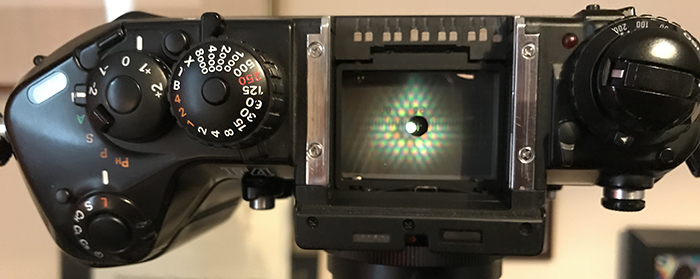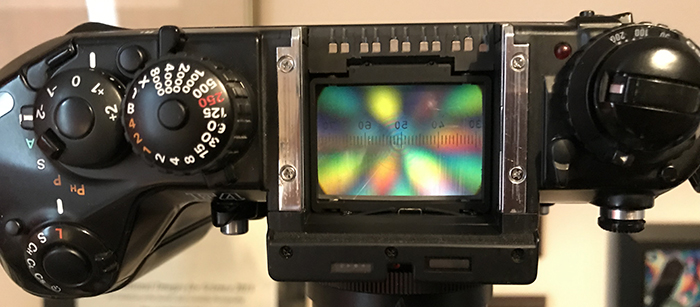Like many microscopy enthusiasts of my generation (now in late 60s) all photomicroscopy before digital techniques became affordable used 35 mm film. Initially with a venerable Nikkormat FT3 film body on a monocular tube for my LOMO Biolam. A later purchase of a used Zeiss Photomicroscope III allowed for more seamless imaging. The PMIII remains my workhorse microscope for all techniques but
have used a digital SLR body since the mid 90s, currently a Canon 600D with APS sensor.
The benefits of digital techniques over film especially for photomicroscopy have been widely discussed and are well known. However, both my brother Ian and I still have a fond affection for film photography both on and off the microscope. The Nikkormat was never ideal for photomicroscopy so treated ourselves to a former Nikon flagship the F4 between us. A model we could only drool over in adverts when current but working examples can now be typically bought on eBay from £100 - £250 depending on condition and accessories. This model appealed because the Fx range had removable pentaprisms and interchangeable focussing screens so was keen to assess how well these cameras worked with the correct screens recommended for photomicrography*.
* Why not just reuse the Photomicroscope with film ... I did and it was a disaster. The complex electromechanical gubbins worked fine over ten years ago but after loading a film and trying to set for use, the 'scope exploded into life with continuous whirring and repeated shutter activations. It 'ate' a whole film in a few seconds, almost £10 lost instantly (film+postage)! When I related this episode in a Facebook group a Zeiss tech remarked that he always carried a used film roll to check out a Photomicroscope repair in case it threw a hissy fit. The internals are so complex that a homebrew repair was unlikely.
Nikkormat FT3 as scene setter
As the cheapest Nikon body that could afford at the time it performs tolerably well on a microscope. It has a mirror lock and the setting of film speed on a lens mount collar worked well enough. The simple match needle metering allowed an idea where to exposure bracket. The central clear split image focus screen on some microscopes, notably the LOMO if viewed slightly off-axis allowed a clear area for focussing. The shutter speed set and meter seen in the viewfinder was illuminated by light through the lens or body
if on a microscope—a key feature that came to appreciate when using the F3 or F4 below.
Nikon F4
The type B screen is fitted as standard to each for general photography. The type C screen recommended for work such as photomicrography was purchased, readily available used for modest cost online. The screen fits on the body so when camera faces downward the screen is also conveniently presented horizontally near eye level. So far so good. However both screens gave odd artefacts as shown below which rendered them both unusable for photomicroscopy.
The artefacts look like diffraction patterns. The F4 camera may have inherited from the F3 design the 150,000 tiny holes in the mirror to pass light through to the metering. My suspicion is that this is the cause if the array of holes are acting as a diffraction grating for light reflected off the mirror to the viewfinder. Unfortunately it renders it unsuitable for microscopy on my setup. I do not believe it is microscope related such as the projection method. A query in both the Nikonians forum and a large microscopy forum provided no suggestions.

Nikon F4 body with type C focussing screen. This has finer matte and clear centre with cross for aerial focussing.
Micrometer slide as subject. Zeiss Kpl 10X W on low collar for projection.

Nikon F4 body with type B default Fresnel focussing screen. Micrometer slide as subject. Zeiss Kpl 10X W on low collar for projection.
Another weakness of the F4 for microscopy studies is that the exposure info' in the viewfinder is illuminated by incident light via a window on the body. This is barely lit when pointing down on a microscope. The type C screens are also not Fresnel and gave marked light fall-off towards the edges. The type M with Fresnel on hindsight may be better if body had been artefact free.
My brother Ian and I assessed and tried the F4 for normal photo' work and we preferred the simplicity and build of the Nikkormat. One of the benefits of buying heavily depreciated cameras is that can resell with little loss which we did, in fact made a slight profit. The Nikkormat FT3 will remain our film classic if ever needed and even if not used it is still nice just to handle occasionally. The Nikkor lenses owned all work well on my Canon 600D with adapter.
Another downside of film work nowadays was the cost. Film canisters are in the Royal Mail small parcel post category so almost £3 to buy or send for processing. The total cost from buying film by post, sending off for developing / printing for B&W was typically £26 and £18 for colour. Given the often low success rate with photomicroscopy with film, this was too much to bear even returning to the Nikkormat. I use to do my own B&W film processing but so infrequently the chemicals were always expired. Ilford do a two film B&W Simplicity processing kit but at ca. £16 is much more costly than sending for commercial processing.
I would welcome feedback from readers who can either offer explanations on the artefacts, confirm my own suspicions or have successfully used either the Nikon F3 or F4 for photomicrosopy.
Comments to the author David Walker are welcomed.